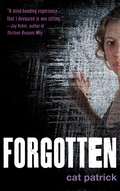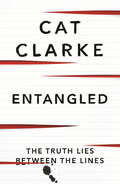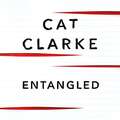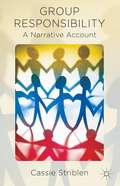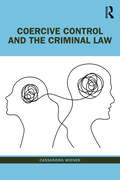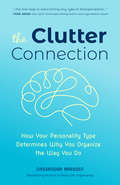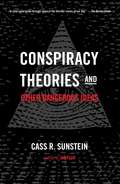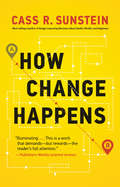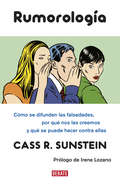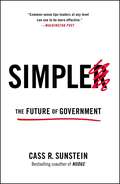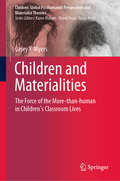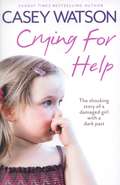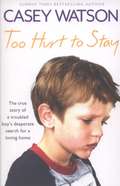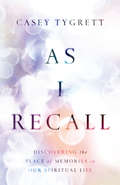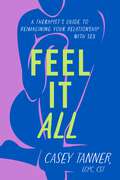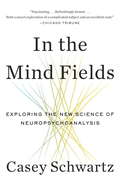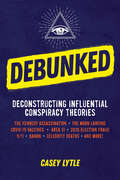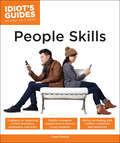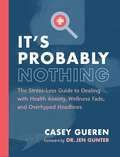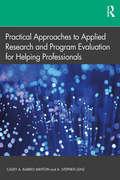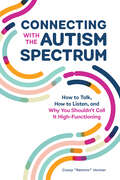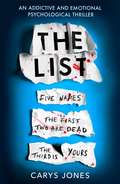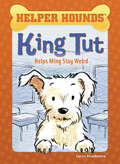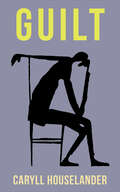- Table View
- List View
Forgotten (Forgotten Series #1)
by Cat PatrickEach night at precisely 4:33 am, while sixteen-year-old London Lane is asleep, her memory of that day is erased. In the morning, all she can "remember" are events from her future. London is used to relying on reminder notes and a trusted friend to get through the day, but things get complicated when a new boy at school enters the picture. Luke Henry is not someone you'd easily forget, yet try as she might, London can't find him in her memories of things to come. When London starts experiencing disturbing flashbacks, or flash-forwards, as the case may be, she realizes it's time to learn about the past she keeps forgetting-before it destroys her future.
Entangled
by Cat ClarkeReal, compulsive and intense: Cat Clarke is the queen of emotional suspense. For fans of Paula Hawkins, Gillian Flynn, Megan Abbott and Jandy Nelson.Seventeen-year-old Grace wakes up in a white room, with table, pens and paper - and no clue how she got there. As Grace starts writing, pouring her tangled life onto the page, she is forced to remember everything she's tried to forget: falling hopelessly in love with Nat, and the unravelling of her friendship with her best mate Sal. But there's something missing. As hard as she's trying to remember, is there something she just can't see? Grace must face the most important question of all. Why is she here? A compulsive thriller of dangerous secrets, intense friendships and electrifying attraction.
Entangled
by Cat ClarkeReal, compulsive and intense: Cat Clarke is the queen of emotional suspense. For fans of E Lockhart, Gillian Flynn and Paula Hawkins. Seventeen-year-old Grace wakes up in a white room, with table, pens and paper - and no clue how she got there. As Grace starts writing, pouring her tangled life onto the page, she is forced to remember everything she's tried to forget: falling hopelessly in love with Nat, and the unravelling of her friendship with her best mate Sal. But there's something missing. As hard as she's trying to remember, is there something she just can't see? Grace must face the most important question of all. Why is she here? A compulsive thriller of dangerous secrets, intense friendships and electrifying attraction.(P) 2017 Hachette Children's Group
Group Responsibility
by Cassie StriblenDrawing on work in social psychology, narrative ethics, and feminist philosophy, the author presents a new account which answers the standard objections while also giving practical guidance to individuals who take their group-related responsibilities seriously.
Coercive Control and the Criminal Law
by Cassandra WienerThis book considers how a phenomenon as complex as coercive control can be criminalised. The recognition and ensuing criminalisation of coercive control in the UK and Ireland has been the focus of considerable international attention. It has generated complex questions about the "best" way to criminalise domestic abuse. This work reviews recent domestic abuse criminal law reform in the UK and Ireland. In particular, it defines coercive control and explains why using traditional criminal law approaches to prosecute it does not work. Laws passed in England and Wales versus Scotland represent two different approaches to translating coercive control into a criminal offence. This volume explains how and why the jurisdictions have taken different approaches and examines the advantages and disadvantages of each. As jurisdictions around the world review what steps need to be taken to improve national criminal justice responses to domestic abuse, the question of what works, and why, at the intersection of domestic abuse and the criminal law has never been more important. As such, the book will be a vital resource for lawyers, policy-makers and activists with an interest in domestic abuse law reform.
The Clutter Connection: How Your Personality Type Determines Why You Organize the Way You Do
by Cassandra AarssenYou&’re not messy—you just organize differently. Learn to make your natural habits work for you with this bestseller by the host of HGTV&’s Hot Mess House! Organizing isn&’t one size fits all. By discovering your unique Organizing Personality Type, you can find the most effective strategies for a more productive and clutter-free life. The Clutter Connection examines and explains how different brain types directly relate to organization and clutter. Cassandra Aarssen smashes the stereotype that some people are &“naturally messy&” and offers insight and real-life solutions based on your unique personal organizing style. The Clutter Connection will help you get organized, be more productive and finally understand the why behind your clutter. Find out what type of Clutterbug you are and learn: · The four different organizing styles and how they relate to each other · How motivation and happiness can be directly affected by our space · The &“3P&’s&”─Productivity, procrastination, and perfectionism, and how they&’re connected to your unique organizing style · How you can finally become clutter-free simply by knowing yourself better
Conspiracy Theories and Other Dangerous Ideas
by Cass R. SunsteinThe nation's most-cited legal scholar who for decades has been at the forefront of applied behavioral economics, and the bestselling author of Nudge and Simpler, Cass Sunstein is one of the world's most innovative thinkers in the academy and the world of practical politics. In the years leading up to his confirmation as the administrator of the White House Office of Information and Regulatory Affairs (OIRA), Sunstein published hundreds of articles on everything from same-sex marriage to cost-benefit analysis. Conspiracy Theories and Other Dangerous Ideas is a collection of his most famous, insightful, relevant, and inflammatory pieces. Within these pages you will learn: * Why perfectly rational people sometimes believe crazy conspiracy theories * What wealthy countries should and should not do about climate change * Why governments should allow same-sex marriage, and what the "right to marry" is all about * Why animals have rights (and what that means) * Why we "misfear," meaning get scared when we should be unconcerned and are unconcerned when we should get scared * What kinds of losses make us miserable, and what kinds of losses are absolutely fine * How to find the balance between religious freedom and gender equality * And much more . . . Cass Sunstein is a unique, controversial, and exciting voice in the political world. A man who cuts through the fog of left vs. right arguments and offers logical, evidence-based, and often surprising solutions to today's most challenging questions.
How Change Happens (The\mit Press Ser.)
by Cass R. SunsteinThe different ways that social change happens, from unleashing to nudging to social cascades."Sunstein's book is illuminating because it puts norms at the center of how we think about change."—David Brooks, The New York TimesHow does social change happen? When do social movements take off? Sexual harassment was once something that women had to endure; now a movement has risen up against it. White nationalist sentiments, on the other hand, were largely kept out of mainstream discourse; now there is no shortage of media outlets for them. In this book, with the help of behavioral economics, psychology, and other fields, Cass Sunstein casts a bright new light on how change happens.Sunstein focuses on the crucial role of social norms—and on their frequent collapse. When norms lead people to silence themselves, even an unpopular status quo can persist. Then one day, someone challenges the norm—a child who exclaims that the emperor has no clothes; a woman who says “me too.” Sometimes suppressed outrage is unleashed, and long-standing practices fall. Sometimes change is more gradual, as “nudges” help produce new and different decisions—apps that count calories; texted reminders of deadlines; automatic enrollment in green energy or pension plans. Sunstein explores what kinds of nudges are effective and shows why nudges sometimes give way to bans and mandates. Finally, he considers social divisions, social cascades, and “partyism,” when identification with a political party creates a strong bias against all members of an opposing party—which can both fuel and block social change.
Rumorología
by Cass R. Sunstein¿Por qué los seres humanos aceptan los rumores, incluso si son falsos, destructivos o estrambóticos? ¿Por qué la misma historia que viaja por Internet tiene credibilidad entre un grupo de personas, mientras que otros la consideran absurda? ¿Qué podemos hacer para protegernos de los efectos perniciosos de los rumores falsos?Los rumores son tan antiguos como la historia humana; siempre hemos vivido rodeados de ellos o incluso sufrido sus consecuencias. Del mismo modo que a través del conocimiento de otros sabemos que la tierra no es plana o que la materia se compone de átomos, los rumores se propagan entre todo tipo de personas --sensatas, razonables, de izquierdas o derechas---, y están ligados a sus deseos y temores.El derecho de los ciudadanos a decir lo que piensan constituye uno de los pilares de los sistemas democráticos en que vivimos, y sin embargo, en la era de Internet, donde uno de estos bulos puede crecer exponencialmente en tan solo unas horas, es fundamental proteger a las posibles víctimas de comportamientos maldicientes. Ayudado por ejemplos de la vida real y estudios de la conducta, Sunstein aborda la compleja tarea de analizar los mecanismos que alimentan los rumores para tratar de encontrar ese equilibrio indispensable entre la necesidad de protegernos de ellos y la salvaguarda de derechos como la libertad de prensa y opinión, y así evitar que la era de la información termine convirtiéndose en la era de la desinformación.
Simpler
by Cass R. SunsteinSimpler government arrived four years ago. It helped put money in your pocket. It saved hours of your time. It improved your children's diet, lengthened your life span, and benefited businesses large and small. It did so by issuing fewer regulations, by insisting on smarter regulations, and by eliminating or improving old regulations. Cass R. Sunstein, as administrator of the most powerful White House office you've never heard of, oversaw it and explains how it works, why government will never be the same again (thank goodness), and what must happen in the future. Cutting-edge research in behavioral economics has influenced business and politics. Long at the forefront of that research, Sunstein, for three years President Obama's "regulatory czar" heading the White House Office of Information and Regulatory Affairs, oversaw a far-reaching restructuring of America's regulatory state. In this highly anticipated book, Sunstein pulls back the curtain to show what was done, why Americans are better off as a result, and what the future has in store. The evidence is all around you, and more is coming soon. Simplified mortgages and student loan applications. Scorecards for colleges and universities. Improved labeling of food and energy-efficient appliances and cars. Calories printed on chain restaurant menus. Healthier food in public schools. Backed by historic executive orders ensuring transparency and accountability, simpler government can be found in new initiatives that save money and time, improve health, and lengthen lives. Simpler: The Future of Government will transform what you think government can and should accomplish.
Children and Materialities: The Force of the More-than-human in Children’s Classroom Lives (Children: Global Posthumanist Perspectives and Materialist Theories)
by Casey Y. MyersThis book makes the case for young children as both keenly materially aware of and highly dependent on sets of interrelated material-discursive circumstances. It argues that long-term engagement with children around the topic of meaning-matter relations upends many taken-for-granted notions of consumption, self-regulation, knowledge production, and what constitutes quality of life within a school setting.The book provides complex accounts of agency on multiple scales - the capability of children to shape and share research, the force of objects, stuff, and things to impact the "social" workings of a classroom, and the impact of nonhuman animals on the trajectory of the ways in which children relate to each other.This work makes a significant contribution to both theoretical conceptions and practical enactments of childhoods, productively addressing the many contradictions inherent in a posthuman and participatory approach to researching with young children. It also offers insights into how the everyday materialities of children’s classrooms (and their complex representations) are capable of disrupting the common-sense order of things.
Crying for Help: The Shocking True Story of a Damaged Girl with a Dark Past
by Casey WatsonThe second book from Sunday Times bestselling author Casey Watson. Two weeks after saying farewell to her first foster child, Casey is asked to look after Sophia, a troubled 12-year-old with a sad past. Sophia s actions are disturbing and provocative and, before long, Casey and her family find themselves in a dark and dangerous situation. Two years ago Sophia s mother had a terrible accident. Sophia has been in care ever since. Right away, Casey feels something isn t right. Sophia s a well-developed girl, who looks more like 18 than 12. She only seems to have eyes and ears for men, and treats all women with contempt and disgust. And she has everyone around her jumping through hoops. Over time, as more details begin to emerge about Sophia s past, it becomes clear that her behaviour is a front for an early life filled with pain and suffering. But although Casey feels she is gradually breaking through to Sophia and getting her to open up about things she has never spoken about before, her violence is threatening the safety of the whole family, forcing Casey to question whether she can really handle this lost and damaged girl. Both shocking and inspiring, this true story will shed new light on the extreme and sometimes dangerous nature of foster care. "
Too Hurt to Stay: The True Story of a Troubled Boy's Desperate Search for a Loving Home
by Casey WatsonEight-year-old Spencer takes himself to social services and demands to be taken into care.Casey is determined to try and understand what Spencer is going through and help him find the loving home he is so desperately searching for.
As I Recall: Discovering the Place of Memories in Our Spiritual Life
by Casey TygrettWhat if our memories are like shells we gather on a beach? According to pastor and spiritual director Casey Tygrett, "We—and all those who have come before us—pick up the experience and we sense it: we feel its edges, notice its color, we smell the distinctive character (for shells it is the sickly seafood salt smell) of the experience and we try to make sense of what it is. Is it beautiful? How would you describe the color—the tones, the shades, wrapped around the ridges and swirls? Has it been damaged? Does the hard edge scrape our hand, leaving a blemish or a mark?" How we hold and carry these memories—good and bad—is a part of what forms us spiritually. In this way we have a common bond with the people of Scripture who also had a sensory life, gathering shells and trying to make sense of them. In these pages Casey Tygrett explores the power of memory and offers biblical texts and practices to guide us in bringing our memories to God for spiritual transformation.
Feel It All: A Therapist's Guide to Reimagining Your Relationship with Sex
by Casey TannerA groundbreaking guide to sexuality that dispels the stale cultural attitudes about sex that leave too many feeling inadequate, and offers an expansive, attachment-based framework to free us and develop bolder, more satisfying relationships with our sexual selves.When it comes to sex, most people feel insecure. But it’s not because we’re deficient; it’s because we’ve been under-resourced and miseducated. Certified sex therapist Casey Tanner argues that our sex lives are a microcosm of every untruth we’ve internalized about gender, sex, relationships, our bodies, and ourselves. Most of us were taught that healthy sexuality is only for a certain kind of person, in a certain kind of relationship, with a certain kind of body. As a result, the way we’ve learned how to define “good sex” is reflective of how good, worthy, and loveable we see ourselves.Feel It All is a comprehensive guide to help everyone uncover their personal misconceptions about sexuality and relationships. Tanner helps you recognize and assess your core beliefs surrounding relationships, sexuality, gender, and more; identify past trauma; find pathways to healing that work for you; and redefine sex based on knowledge and possibilities, rather than potential consequences.Comprehensive yet accessible, informative, warm, and nonjudgmental, Feel It All provides a pathway for personal healing, creating stronger relationships, and achieving deeper intimacy.
In the Mind Fields
by Casey Schwartz"Everywhere I looked it seemed that we were being defined by what our brains were doing . . . Everywhere, there were hucksters and geniuses, all trying to colonize the new world of the brain." "I'd never been a science person," Casey Schwartz declares at the beginning of her far-reaching quest to understand how we define ourselves. Nevertheless, in her early twenties, she was drawn to the possibilities and insights emerging on the frontiers of brain research. Over the next decade she set out to meet the neuroscientists and psychoanalysts engaged with such questions as, How do we perceive the world, make decisions, or remember our childhoods? Are we using the brain? Or the mind? To what extent is it both? Schwartz discovered that neuroscience and psychoanalysis are engaged in a conflict almost as old as the disciplines themselves. Many neuroscientists, if they think about psychoanalysis at all, view it as outdated, arbitrary, and subjective, while many psychoanalysts decry neuroscience as lacking the true texture of human experience. With passion and humor, Schwartz explores the surprising efforts to find common ground. Beginning among the tweedy Freudians of North London and proceeding to laboratories, consulting rooms, and hospital bedsides around the world, Schwartz introduces a cast of pioneering characters, from Mark Solms, a South African neuropsychoanalyst with an expertise in dreams, to David Silvers, a psychoanalyst practicing in New York, to Harry, a man who has lost his use of language in the wake of a stroke but who nevertheless benefits from Silvers's analytic technique. In the Mind Fields is a riveting view of the convictions, obsessions, and struggles of those who dedicate themselves to the effort to understand the mysteries of inner life.From the Hardcover edition.
Debunked EBK: Separate the Rational from the Irrational in Influential Conspiracy Theories
by Casey LytleHead down the rabbit hole and feed your fascination for conspiracy and controversy. Conspiracy theories-they're influential and spread to sometimes irrational extremes. Why do people cling to conspiracy theories so powerfully? Is there a way to separate the possible from the impossible? Yes. Enter: Debunked.Conspiracy theories pop up surrounding every major national and global event-some are possible, some are not. TikTok influencer and psychology professor Casey Lytle will teach you how to be an intelligent consumer of "alternative" theories. Lytle's trademark "project management approach" will help you discern possible from impossible in the popular and controversial theories surrounding 10 national and global events.9/11-No fewer than 10 alternative theories have gained traction. But let's evaluate: Did the Twin Towers really look like a controlled demolition? Would jet fuel have to melt steel for the towers to collapse? What would it take in hours and people to secretly plant enough explosives to bring the buildings down without being discovered, and without being set off by the impact and fires from the planes? All this and more in Chapter 7.COVID-19-The vaccine implants a microchip used to track people; the fatality rate has been wildly inflated; oh, and Bill Gates is not only responsible for the virus but also the head of a plot to use the virus as population control.School shooters-why are they so easy to explain, but so hard to predict? In what ways has the profile of a school shooter changed over the last 25 years, and what has caused those changes? Are school shootings a new phenomenon, or does the media simply make us more aware of them when they happen? The chapter will cover Sandy Hook conspiracy theories, as well as the psychology behind "truthers."
People Skills: Helpful Guidance on Interacting in Any Situation (Idiot's Guides)
by Casey HawleyPeople skills — also known as interpersonal skills — are key to succeeding in work and in life. Many people struggle with these specific skills, particularly in an increasingly digital world. Idiot's Guides: People Skills offers expert advice on the foundations of effective communication, tips on understanding and maximizing nonverbal communication, ways to handle conflict and difficult conversations, pointers on being more influential and persuasive, and a primer for public speaking to small or large groups.
It's Probably Nothing: The Stress-Less Guide to Dealing with Health Anxiety, Wellness Fads, and Overhyped Headlines
by Casey GuerenFrom stress-induced symptom searching and "miracle cures" to the wellness fads filling your social media timeline, health journalist Casey Gueren digs into why we're so anxious about our health and how to separate medical facts from fiction. Surrounded by &“health hacks&” and clickbait headlines, it&’s easy to feel overwhelmed and underprepared when it comes to taking care of your health. But despite what the wellness industry told you, you don&’t need another cleanse, detox, or supplement—you need a crash course in separating hype from health.In It's Probably Nothing you&’ll find a health journalist&’s tools and tips to. . . Fine-tune your B.S. detector and spot the wellness industry&’s sneaky tricksGet answers to your health questions without spiraling down search holesManage health stress and learn to listen to your body (just enough)Decode the latest overhyped health headlinesFind compassionate, evidence-based care that works for youAnd so much more Packed with illuminating information, funny personal anecdotes, concrete strategies for coping, quotes from dozens of medical experts, and a foreword by New York Times-bestselling author of The Vagina Bible Dr. Jen Gunter, this book is the perfect companion for navigating our wellness-obsessed world with a little less stress and a lot more information.
Practical Approaches to Applied Research and Program Evaluation for Helping Professionals
by Casey A. Barrio Minton A. Stephen LenzPractical Approaches to Applied Research and Program Evaluation for Helping Professionals is a comprehensive textbook that presents master’s-level counseling students with the skills and knowledge they need to successfully evaluate the effectiveness of mental health services and programs. Each chapter, aligned with 2016 Council for Accreditation of Counseling and Related Educational Programs (CACREP) standards, guides counseling students through study design and evaluation fundamentals that will help them understand existing research and develop studies to best assess their own applied research questions. Readers will learn the basics of research concepts as applied to evaluative tasks, the art of matching evaluative methods to questions, specific considerations for practice-based evaluative tasks, and practical statistical options matched to practice-based tasks. Readers can also turn to the book’s companion website to access worksheets for practitioner and student planning exercises, spreadsheets with formulas for basic data analysis, a sample database, PowerPoint outlines , and discussion questions and activities aligned to each chapter.
Connecting With The Autism Spectrum: How To Talk, How To Listen, And Why You Shouldn't Call It High-Functioning
by Casey "Remrov" VormerThe complete guide to connecting with adults on the autism spectrum - one of the 2021 Best Books on Autism from ChoosingTherapy.comFor a friend, family member, or coworker with autism, communication can be challenging. But Connecting with the Autism Spectrum can help you find common ground with expert tips and helpful insights about talking (and listening) to neurodiverse adults so you can make your interactions more transparent, meaningful, and rewarding for all.Written by Casey Vormer, a self-taught artist and autism advocate, this comprehensive guide is a trusted source for understanding neurodiversity that features a brief introduction to the autism spectrum. It also provides easy communication strategies like active listening and positive encouragement as well as steps to avoid misunderstandings by teaching how to recognize biases and correct them. Additionally, you'll learn why the term "high functioning autism" is a misnomer to define members of this vibrant community."It's important to look at every autistic person individually and recognize their obstacles—but more importantly, we should acknowledge their skills and avoid labeling them with 'high functioning autism' or 'low functioning autism' altogether," Vormer says.Unlike other autism books, Connecting with the Autism Spectrum delivers:An easy approach—Discover the best ways to communicate with those living with autism.Situational success—Find the right information for various situations and settings, including school, work, and social relationships.A sensitive tone—Get valuable information from a clear, honest point of view that does not seek to "cure" or manipulate people.Learn how to communicate better with those on the autism spectrum with this informative book.
The List: ‘A terrifyingly twisted and devious story' that will take your breath away
by Carys JonesFive names on a list. The first two are dead.The third is yours.A rip-roaring, addictive, intense and emotional thriller for fans of Lucy Foley, Ruth Ware, Phoebe Morgan, CL Taylor and Lisa Jewell...* * * * * * *Beth Belmont runs every day, hard and fast on the trail near home. She knows every turn, every bump in the road. So when she spots something out of place - a slip of white paper at the base of a tree - she's drawn to it.On the paper are five names. The third is her own.Beth can't shake off the unease the list brings. Why is she on it? And what ties her to the other four strangers?Then she discovers that the first two are dead.Is she next?Delving into the past of the two dead strangers, the truth Beth finds will lead her headlong into her darkest, deadliest and most dangerous nightmares...PRAISE FOR THE LIST:'Compelling, unsettling and utterly addictive, The List got deep under my skin as I read it in a single sitting' M W CRAVEN, author of The Puppet Show'A sharp psychological thriller. A captivating premise and an engrossing read with twists and turns that will keep you hooked to the very last page' ADAM HAMDY, author of Black 13'A terrifying story of guilt and remorse. A chilling reminder that the past doesn't always stay there no matter what stories we tell ourselves or others! The truth sits in the shadows and will always come to light' ALEX HART, author of Take Me Home
The List: ‘A terrifyingly twisted and devious story' that will take your breath away
by Carys JonesFive names on a list. The first two are dead.The third is yours.A rip-roaring, addictive, intense and emotional thriller for fans of Lucy Foley, Ruth Ware, Phoebe Morgan, CL Taylor and Lisa Jewell...* * * * * * *Beth Belmont runs every day, hard and fast on the trail near home. She knows every turn, every bump in the road. So when she spots something out of place - a slip of white paper at the base of a tree - she's drawn to it.On the paper are five names. The third is her own.Beth can't shake off the unease the list brings. Why is she on it? And what ties her to the other four strangers?Then she discovers that the first two are dead.Is she next?Delving into the past of the two dead strangers, the truth Beth finds will lead her headlong into her darkest, deadliest and most dangerous nightmares...PRAISE FOR THE LIST:'Compelling, unsettling and utterly addictive, The List got deep under my skin as I read it in a single sitting' M W CRAVEN, author of The Puppet Show'A sharp psychological thriller. A captivating premise and an engrossing read with twists and turns that will keep you hooked to the very last page' ADAM HAMDY, author of Black 13'A terrifying story of guilt and remorse. A chilling reminder that the past doesn't always stay there no matter what stories we tell ourselves or others! The truth sits in the shadows and will always come to light' ALEX HART, author of Take Me Home
King Tut Helps Ming Stay Weird (Helper Hounds)
by Caryn RivadeneiraMing often gets teased for being "weird." His curious mind and wild imagination make him extra nervous for his school's upcoming lockdown drill after a deadly dance hall shooting. His teacher calls the Helper Hounds to help calm his nerves and King Tut comes to the rescue! King Tut knows all about being weird—she's been in some scary situations herself after being abandoned under a bridge as a puppy. King Tut helps Ming and his classmates through the lockdown drill. Discover how King Tut helps Ming and his friends see the beauty in being "weird."
Guilt
by Caryll HouselanderDiscover the fascinating work of Caryll Houselander, a lay Catholic artist, mystic, religious writer, and poet in this thought-provoking book. Exploring the concept of guilt in the context of man's relationship with Christ, she reveals how breakdowns in this relationship manifest as psychological disfunction, and argues that only through suffering can we achieve sanity and become whole. Houselander illustrates these arguments through a series of case studies centered around famous authors, artists, and criminals, including as Leopold and Loeb, Teresa Martin, Hans Christian Andersen, and Franz Kafka, With her unique perspective and expertise, Houselander's examination of guilt, suffering, and mental instability is a must-read for anyone interested in the intersection of religion and psychology.
